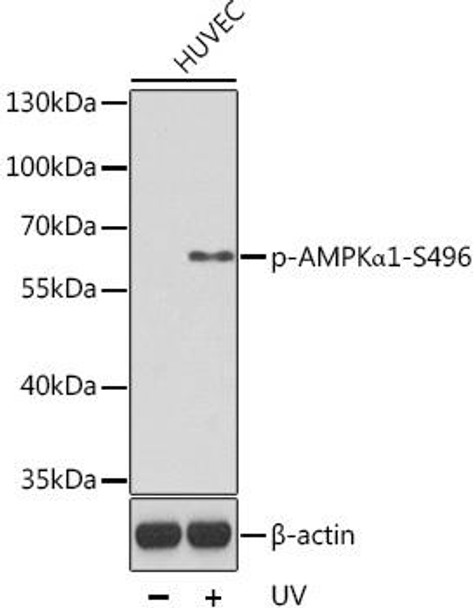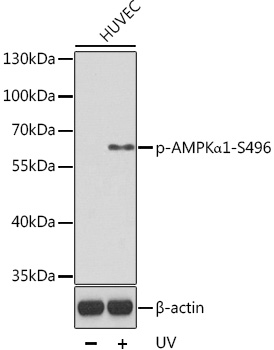Anti-Phospho-PRKAA1-S496 Antibody (CABP0619)
- SKU:
- CABP0619
- Product type:
- Antibody
- Application:
- WB
- Application:
- IHC
- Application:
- IF
- Reactivity:
- Human
- Host Species:
- Rabbit
- Isotype:
- IgG
- Research Area:
- Autophagy
Frequently bought together:
Description
| 抗体名: | Anti-Phospho-PRKAA1-S496 Antibody |
| 抗体コード: | CABP0619 |
| 抗体サイズ: | 100 uL |
| 申し込み: | WB IHC IF |
| 反応性: | Human |
| 宿主種: | Rabbit |
| 免疫原: | A phospho specific peptide corresponding to residues surrounding S496 of human PRKAA1. |
| 申し込み: | WB IHC IF |
| 推奨希釈: | WB 1:500 - 1:1000 IHC 1:50 - 1:100 IF 1:50 - 1:100 |
| 反応性: | Human |
| ポジティブサンプル: | HUVEC |
| 免疫原: | A phospho specific peptide corresponding to residues surrounding S496 of human PRKAA1. |
| 精製方法: | Affinity purification |
| ストレージバッファ: | Store at -20°C. Avoid freeze / thaw cycles. Buffer: PBS with 0.02% sodium azide, 50% glycerol, pH7.3. |
| アイソタイプ: | IgG |
| 順序: | Email for sequence |
| 遺伝子ID: | 5562 |
| Uniprot: | Q13131 |
| セルラーロケーション: | Cytoplasm, Nucleus |
| 計算された分子量: | 64kDa/65kDa |
| 観察された分子量: | 64kDa |
| 同義語: | PRKAA1, AMPK, AMPKa1 |
| バックグラウンド: | The protein encoded by this gene belongs to the ser/thr protein kinase family. It is the catalytic subunit of the 5'-prime-AMP-activated protein kinase (AMPK). AMPK is a cellular energy sensor conserved in all eukaryotic cells. The kinase activity of AMPK is activated by the stimuli that increase the cellular AMP/ATP ratio. AMPK regulates the activities of a number of key metabolic enzymes through phosphorylation. It protects cells from stresses that cause ATP depletion by switching off ATP-consuming biosynthetic pathways. Alternatively spliced transcript variants encoding distinct isoforms have been observed. |
| UniProt Protein Function: | Catalytic subunit of AMP-activated protein kinase (AMPK), an energy sensor protein kinase that plays a key role in regulating cellular energy metabolism. In response to reduction of intracellular ATP levels, AMPK activates energy-producing pathways and inhibits energy-consuming processes: inhibits protein, carbohydrate and lipid biosynthesis, as well as cell growth and proliferation. AMPK acts via direct phosphorylation of metabolic enzymes, and by longer-term effects via phosphorylation of transcription regulators. Also acts as a regulator of cellular polarity by remodeling the actin cytoskeleton; probably by indirectly activating myosin. Regulates lipid synthesis by phosphorylating and inactivating lipid metabolic enzymes such as ACACA, ACACB, GYS1, HMGCR and LIPE; regulates fatty acid and cholesterol synthesis by phosphorylating acetyl-CoA carboxylase (ACACA and ACACB) and hormone-sensitive lipase (LIPE) enzymes, respectively. Regulates insulin-signaling and glycolysis by phosphorylating IRS1, PFKFB2 and PFKFB3. AMPK stimulates glucose uptake in muscle by increasing the translocation of the glucose transporter SLC2A4/GLUT4 to the plasma membrane, possibly by mediating phosphorylation of TBC1D4/AS160. Regulates transcription and chromatin structure by phosphorylating transcription regulators involved in energy metabolism such as CRTC2/TORC2, FOXO3, histone H2B, HDAC5, MEF2C, MLXIPL/ChREBP, EP300, HNF4A, p53/TP53, SREBF1, SREBF2 and PPARGC1A. Acts as a key regulator of glucose homeostasis in liver by phosphorylating CRTC2/TORC2, leading to CRTC2/TORC2 sequestration in the cytoplasm. In response to stress, phosphorylates 'Ser-36' of histone H2B (H2BS36ph), leading to promote transcription. Acts as a key regulator of cell growth and proliferation by phosphorylating TSC2, RPTOR and ATG1/ULK1: in response to nutrient limitation, negatively regulates the mTORC1 complex by phosphorylating RPTOR component of the mTORC1 complex and by phosphorylating and activating TSC2. In response to nutrient limitation, promotes autophagy by phosphorylating and activating ATG1/ULK1. AMPK also acts as a regulator of circadian rhythm by mediating phosphorylation of CRY1, leading to destabilize it. May regulate the Wnt signaling pathway by phosphorylating CTNNB1, leading to stabilize it. Also has tau-protein kinase activity: in response to amyloid beta A4 protein (APP) exposure, activated by CAMKK2, leading to phosphorylation of MAPT/TAU; however the relevance of such data remains unclear in vivo. Also phosphorylates CFTR, EEF2K, KLC1, NOS3 and SLC12A1. |
| NCBI Summary: | The protein encoded by this gene belongs to the ser/thr protein kinase family. It is the catalytic subunit of the 5'-prime-AMP-activated protein kinase (AMPK). AMPK is a cellular energy sensor conserved in all eukaryotic cells. The kinase activity of AMPK is activated by the stimuli that increase the cellular AMP/ATP ratio. AMPK regulates the activities of a number of key metabolic enzymes through phosphorylation. It protects cells from stresses that cause ATP depletion by switching off ATP-consuming biosynthetic pathways. Alternatively spliced transcript variants encoding distinct isoforms have been observed. [provided by RefSeq, Jul 2008] |
| UniProt Code: | Q13131 |
| NCBI GenInfo Identifier: | 254763436 |
| NCBI Gene ID: | 5562 |
| NCBI Accession: | Q13131.4 |
| UniProt Secondary Accession: | Q13131,O00286, Q5D0E1, Q86VS1, Q9UNQ4, A8MTQ6, B2R7E1 |
| UniProt Related Accession: | Q13131 |
| Molecular Weight: | 65,523 Da |
| NCBI Full Name: | 5'-AMP-activated protein kinase catalytic subunit alpha-1 |
| NCBI Synonym Full Names: | protein kinase AMP-activated catalytic subunit alpha 1 |
| NCBI Official Symbol: | PRKAA1 |
| NCBI Official Synonym Symbols: | AMPK; AMPKa1 |
| NCBI Protein Information: | 5'-AMP-activated protein kinase catalytic subunit alpha-1 |
| UniProt Protein Name: | 5'-AMP-activated protein kinase catalytic subunit alpha-1 |
| UniProt Synonym Protein Names: | Acetyl-CoA carboxylase kinase (EC:2.7.11.27 |
| UniProt Gene Name: | PRKAA1 |


